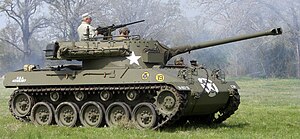M18 Hellcat
| 76 mm Gun Motor Carriage M18 | |
|---|---|
 |
|
| Type | Tank destroyer |
| Place of origin | United States |
| Production history | |
| Designed | 1942 |
| Manufacturer | Buick Motor Division of General Motors |
| Unit cost | $55,230 |
| Produced | July 1943 – October 1944 |
| No. built | 2,507 |
| Specifications () | |
| Weight | 39,000 lb (17.7 metric tons) |
| Length | 17 ft 4 in (5.28 m) hull 21 ft 10 in (6.6 m) including gun |
| Width | 9 ft 5 in (2.87 m) |
| Height | 8 ft 5 in (2.57 m) over antiaircraft machine gun |
| Crew | 5 (Commander, gunner, loader, driver, assistant driver) |
|
|
|
| Armor | 4.8-25.4 mm (0.19-1.0 inches) |
|
Main
armament |
76 mm gun M1A1, M1A1C, or M1A2 45 rounds |
|
Secondary
armament |
.50 caliber (12.7 mm) Browning M2HB machine gun 800 rounds |
| Engine | Continental R975-C1 or C4; 350 or 400 hp (261 kW-298 kW) at 2,400 rpm |
| Power/weight | 19.8 -22.6 horsepower/metric ton |
| Transmission | 900T Torqmatic automatic transmission 3 speeds forward, 1 reverse |
| Suspension | Torsion bar |
| Fuel capacity | 165 US gallons (625 litres) |
|
Operational
range |
100 mi (160 km) on road |
| Speed | 50 mph (80 km/h) on road 18 mph (29 km/h) off road |
The M18 Hellcat (officially designated the 76 mm Gun Motor Carriage M18 or M18 GMC) was an American tank destroyer of World War II, used in the Italian, European, and Pacific theatres, and in the Korean War. It was the fastest American tracked armored vehicle until the turboshaft-powered M1 Abrams main battle tank appeared decades later. Even then, most sources list the M1 Abrams with a top speed of only 45 mph (governed speed), leaving the Hellcat with a superior paved-road top operating speed. The speed was attained by keeping armor to a minimum, no more than one inch thick and roofless, and by powering the relatively small vehicle with a radial engine originally designed for aircraft usage. The Hellcat, along with the M4 Sherman-based M10 tank destroyer and the highly effective, 90mm gun-armed M36 tank destroyer, provided American and Allied forces with a mobile anti-tank capability against the newer German armored types.
The Hellcat was the most effective American tank destroyer of World War II. It has a higher kill to loss ratio than any tank or tank destroyer fielded by American forces in World War II.
When the Tank Destroyer Force was organized in 1941, their commander, Lieutenant Colonel (later General) Andrew Davis Bruce envisioned the units being equipped with something faster than a tank, with a better gun but less armor to allow for speed, a cruiser rather than a battleship. He objected to the 3 inch M10 Gun Motor Carriage because it was too heavy and slow for his needs, and later on to the 90 mm M36 Gun Motor Carriage because it was essentially an M10 with a bigger gun. The United States Ordnance Corps made several failed attempts to provide said vehicle using the weapons (the 37 mm, 57 mm, 3 inch, 75 mm and finally the lightweight 76 mm of 1942–1943) and technology available, including mounting the 3-inch gun on the fast M3 Light Tank chassis. The M18 was the end product of a long line of research vehicles aimed at providing the desired machine.
...
Wikipedia
